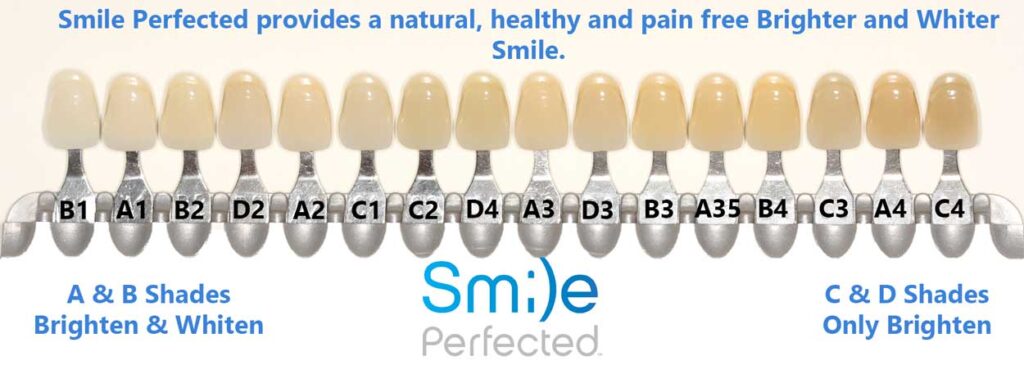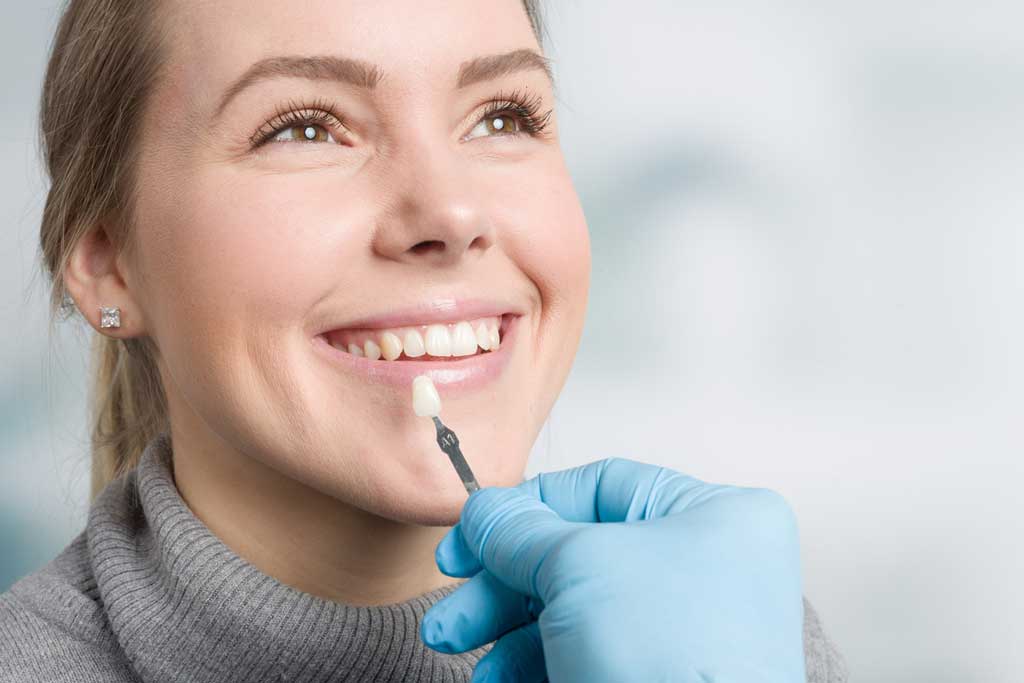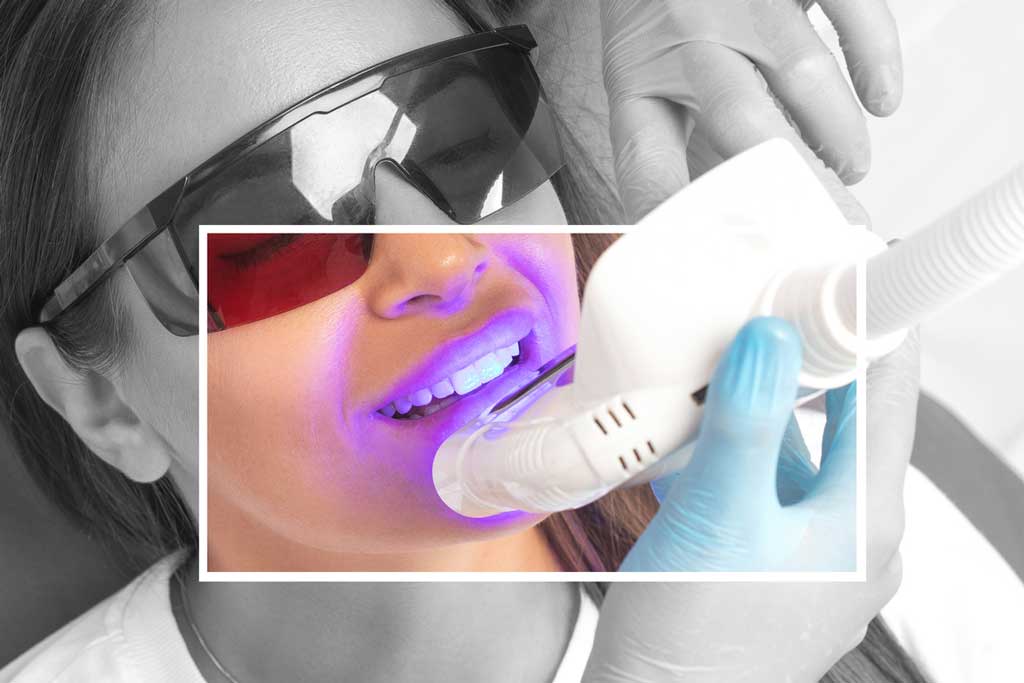Nobody wants mismatched or stained teeth. When dentists treat patients using crowns, veneers, or implants, they are very careful to match the color of their teeth properly. But is the color they are matching a patient’s yellow, stained teeth, or whitened teeth?
Professional teeth whitening treatment allows dental practices to establish a baseline white tooth color to match implants and crowns.
Understanding Dental Implants and Crowns Colors
The color of a person’s natural teeth changes constantly. This is because teeth are alive and can absorb stain-causing foods and drinks.
Conversely, dental prosthetics or fake teeth do not change color; the chosen shade color is permanent.
Dental practices and labs carefully match false teeth to their surrounding teeth. Some dental offices invest in digital spectrophotometers, which are the best way to pick a shade. This equipment accurately chooses the right shade for implant crowns and porcelain veneers.
To pick the right shade, we must first understand the specific technical names for dental prosthetic teeth and whether picking a shade is necessary.
What Are Dental Implants?
Dental implants are not really false teeth. Dental Implants are titanium posts that are embedded in your jaw. They bond into the bone, and once the gums heal, they will never be seen.
The porcelain crown, which is attached to the top of the implant abutment, needs a correctly chosen shade.
Dental implant provider Rocky Mountain Smiles takes great care in selecting the matching shade of tooth before making the implant. Teeth whitening is an important part of any full-mouth restoration they are providing.
What Are Dental Crowns?
Dental crowns are caps that rest on top of the implant abutment or the remaining healthy part of the tooth after a root canal. They are usually made of porcelain or zirconium.
These crowns look and feel just like natural teeth. The main difference is that these dental materials do not whiten and should match the color of your teeth when used.
The good news is that crowns will never stain from food and drinks. Unfortunately, if the shade taken before making the artificial tooth had tooth stains or was yellow, your crown will be the wrong, stained color.
The best way to make sure you get the right color is to have your teeth whitened before your crown or dental implant procedure.
Benefits of Teeth Whitening Before Dental Procedures
The benefits of whitening before dental procedures are numerous: better results, increased confidence, and more.
Learn more about why you should have brighter and whiter teeth before investing in a new smile.
Matching Dental Work to Your Natural Teeth
Natural teeth are not completely stain-resistant like their artificial replacements. Before choosing a shade, dentists should whiten before a shade is taken so the replacements match the rest of your white smile.
Enhanced Aesthetic Results
Dental work is expensive and lasts years or even decades with proper care and regular dental visits.
Providing the correct tooth color shade is key to ensuring enhanced results that patients can be happy with over the life of the replacement teeth.
A significant benefit of properly matched teeth is more smiles, which in turn leads to higher confidence.
Dental work is expensive and lasts years or even decades with proper care and regular dental visits.
Providing the correct tooth color shade is key to ensuring enhanced results that patients can be happy with over the life of the replacement teeth.
A significant benefit of properly matched teeth is more smiles, which in turn leads to higher confidence.
Not much increases confidence more than an amazing smile. If one fake tooth is a mismatched yellowish color because a shade decision was incorrect, our easy smile and confidence can be diminished.
Newly whitened teeth can help dental professionals and patients avoid the issue of mismatched teeth.
Practical Reasons
Patients can always whiten their teeth to match. However, staining teeth to match is not ideal for several reasons.
The first is that it is virtually impossible to stain your teeth to match a mismatched crown shade. Additionally, stained teeth are the result of poor oral hygiene.
The second is that you can always whiten your teeth to match artificial teeth with the hundreds of different whitening options available.
Teeth Whitening Options
There are hundreds of different whitening products on the market today for those interested in having brighter and whiter teeth. While there are lots of different brands, there are only a few different methods for whitening teeth, and only one whitening element. Hydrogen-Peroxide (HP).
In-Office Professional Whitening
The professional-grade whitening gel is typically more potent and requires the supervision of a dental professional. While it varies from state to state, whitening gels over 25% hydrogen peroxide require dental supervision.
More powerful gels can whiten teeth well, however, the strongest gels (30+ HP) can actually cause teeth to look too white, creating an “unnaturally white smile”. A glow-in-the-dark smile is not ideal.
Therefore, using a gel that is too strong before dental work may result in the color of replacement teeth that is too white.
Dentists sometimes recommend an at-home option for patients so they can whiten to their desired color before matching the color of a replacement tooth.
Professional Strength At-Home Whitening Kits
Mostly, these professional-grade take-home kits are safe for people to use without dental oversight. However, patients who use these kits are sent home with instructions that must be carefully followed to avoid gum or soft tissue irritation.
Dentists use these at-home treatments and allow patients to briefly whiten before replacement tooth treatment is performed.
The preferred method for dentists and hygienists is a combination “hybrid” system that combines both options above.
Hybrid Whitening Systems
Hybrid-whitening systems are a combination of professional-grade in-office teeth whitening and a safe take-home option for patients to continue whitening with.
With this technique, a dentist can give an in-office whitening treatment quickly to find the naturally whitened color for the replacement tooth.
Then, patients can use the take-home whitening option included with their chairside whitening to continue whitening until their reappointment.
When the replacement crown, veneer, or implant is ready, the patient comes in with the same whitened teeth, and the artificial tooth matches perfectly.
A combination system provides the best results for both the dental practice and the patient. Using whitening systems like Smile Perfected, patients and dentists can correctly identify the shade of replacement prosthetics.

Over-the-Counter Whitening Products
Over-the-counter whitening systems do work, but results take longer because lower levels of Hydrogen peroxide must be used to comply with safety regulations.
Whitening strips, whitening toothpaste, and whitening foams allow people to conveniently whiten at home.
The downside is that these less powerful options require lots of use to achieve results. On top of that, the maximum achievable results may not be able to match those of professional-grade options.
Natural Remedies for Teeth Whitening
Over the last couple of years, several “natural” teeth whitening methods have gained popularity. These include coconut oil pulling and more, and results can vary widely. Home remedies work fine for everyday use.
However, when it comes time for dental work, it is recommended that you use proven hydrogen peroxide (HP) whitening processes when attempting to pick the properly matched shade of natural teeth.
Small HP hydroxyl molecules penetrate the enamel fissures and whiten the dentin—these tiny “whitening” hydroxyl molecules are teeth-whitening powerhouses.
Before patients decide to make an appointment today, they should think about at-home methods.
Steps to Take Before Whitening
Before any significant dental replacement treatments, whitening toothpaste or OTC methods before your appointment is a good idea.
These whitening methods will help any professional-grade whitening treatment work better. Another advantage is that your dentist or dental team can match your tooth’s color more accurately when seeing its unstained color.
The best part is that teeth whitening is all about habit. Most people have good habits when it comes to brushing their teeth. By developing the habit of whitening your teeth, you will have a brighter and whiter smile.
Consultation with Your Dentist
Some patients find a consultation with their dentist intimidating. However, they should not hesitate to ask questions about whitening their teeth before treatment.
Some dental practices, like Renew Family Dental, can give patients a quick whitening so they can properly match the replacement tooth color.
Quick teeth whitening usually starts with a professional cleaning.
Professional Cleaning
Professional teeth cleaning allows for the removal of the pellicle layer. This layer is a thin coating that covers the tooth. Unfortunately, this coating makes it difficult to determine a replacement tooth’s color.
Removing this layer with a professional cleaning allows for a fast, more effective in-office whitening before a dental procedure.
Frequently Asked Questions – Dental Teams
- We have patients with existing anterior composites that they want to change because they have yellowed over time. Will the Hybrid Smile Perfected System whiten the fillings?
The Hybrid Smile Perfected Whitening System will improve the fillings somewhat, but there is a better way forward. Tell the patient that if they get their teeth brighter and whiter with Smile Perfected, their fillings may no longer match their teeth.
We recommend that the patient whiten their teeth and have the fillings replaced on the same day. Tell the patient you will whiten their teeth for free if they replace their anterior composite fillings.
- We do a lot of crowns in our office. How do we incorporate the Hybrid Smile Perfected System into our crown clinical protocol?
Ask the patient what color they want their new tooth to be, either before the tooth is prepped for the crown or before the shade is chosen (either before or after the impression).
The patient typically responds with bewilderment. Explain that they have two choices. The first choice is to match the existing darker color of their existing smile, and the second choice is to match the color and shade of a brighter and whiter smile.
If the patient states they may want to whiten later, explain that once the crown is made, there is no way to lighten the porcelain. That is the reason why we need to know now. Do we match your old smile, or do we match the shade of a brighter and whiter smile with Smile Perfected?
Whether a tooth or an implant supports the crown, the patient should be offered a hybrid whitening system BEFORE the final crown shade is selected.
Whether the crown is supported by a tooth or an implant, the patient should be offered a hybrid whitening system BEFORE the final crown shade is selected
- Should we whiten teeth before we prepare and place porcelain veneers?
Veneers are eggshell thin, and the teeth they rest on will show through the porcelain. Techniques exist to opaque or block dark underlying enamel and dentin, but it is truly better to whiten teeth before they are prepped for veneers.
Explain to the patient that their teeth need to be whitened BEFORE they are prepped for the veneers. Further, explain that you want to make sure the remaining teeth (after preparation) have a brighter and whiter foundation, which will give the final veneers a brighter and whiter look and appearance.
Frequently Asked Questions – Patients
Patients should know more as well. Below, patients and dental teams can review commonly asked general questions from patients about to have restorative dental work completed.
How Long Should I Wait After Whitening to Get Implants or Crowns?
Waiting for the gums to heal entirely and all gum irritation to subside is recommended before whitening. Once the gums have completely healed, patients should consider professional whitening multiple times a year.
Are There Any Risks Associated with Teeth Whitening?
In the past, dentists etched teeth enamel to achieve better results with teeth whitening. Etching in combination with teeth whitening is no longer done. Dental professionals will etch teeth for other reasons, however.
Overall, modern teeth whitening gels are made with components that reduce pain and sensitivity. These new gels are safe and offer a risk-free whitening for most patients.
Can Whitening Affect the Outcome of My Dental Work?
Yes. Stained teeth prevent a dentist and his team from properly matching a patient’s tooth shade. Replacement veneers, crowns, and implants may look different from the surrounding teeth.
How many different tooth colors are there to choose from?
If you ask a dentist, they would say there are thousands of different shades of teeth. From a dentist’s perspective, color is actually broken down into chroma, value, and hue. This concept is complex and requires a higher level of education.
Due to the complexity of determining a tooth’s “true” color, companies like VITA have attempted to simplify and categorize tooth shades into four groups for dental professionals. These four main groups are A, B, C, & D. Each group has its subset of colors. For example A1, B3, C2.
Generally, A and B shades are considered “yellowish/white,” while C shades are considered “grey,” and D shades are considered “brownish.”

Conclusion
In conclusion, whitening teeth before treating patients with replacement teeth and prosthetics is important.
Finding the proper shade of teeth is crucial for dental practices. They need an effective and fast solution to complete whitening before restorative treatments. An affordable, quick, hybrid 20-minute whitening solution is extremely helpful in these situations.
Living with the correct shade of replacement teeth is essential for patients because they look in the mirror daily. No patient wants a mismatched tooth color that makes them unhappy with their appearance.
References:
https://vitanorthamerica.com/en-US/VITA-Shade-Guides-349.html
https://www.science.gov/topicpages/t/tooth+whitening+effect.html




